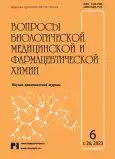Essential oils content in sage medicinal plants as affected by artificial light spectral composition
- Authors: Ivanitskikh A.S.1, Tarakanov I.G.2
-
Affiliations:
- Federal Scientific Agroengineering Center VIM
- Russian State Agrarian University – Moscow Timiryazev Agricultural Academy
- Issue: Vol 26, No 6 (2023)
- Pages: 23-30
- Section: Pharmaceutical chemistry
- URL: https://bakhtiniada.ru/1560-9596/article/view/249957
- DOI: https://doi.org/10.29296/25877313-2023-06-04
- ID: 249957
Cite item
Abstract
Relevance. Sage is a valuable medicinal plant. To obtain ecologically safe products on the background of environmental pollution, as well as climatic zoning restrictions in outdoor cultivation, cultivation of plants can be organized in the controlled environment with artificial lighting. In this case, application of the light-emitting diodes (LEDs) and high-pressure sodium (HPS) lamps requires the development of special light-growing regimes ("light recipes").
The aim of the research. To study the effects of different spectral composition on the qualitative and quantitative composition of sage essential oil components to optimize its cultivation in the controlled environment.
Material and methods. Plants of common sage (Salvia officinalis L.) variety Kubanets were grown in a vegetative experiment under controlled conditions with artificial lighting in the absence of natural light. HPS lamp (reference treatment), white LEDs, as well as narrow-band LEDs with radiation in red and blue regions of PAR were used in the experiment. The amount and component composition of the essential oil in the plant biomass were studied by gas chromatography-mass spectrometry (GC-MS).
Results. Evaluation of the qualitative and quantitative composition of sage extractive substances showed significant differences in the dynamics of component accumulation during the observation period. Thus, the content of 1,8-cineole increased from day 58 to day 110, and the content of α- and β-tuon decreased (exception: the treatment with red light). The content of camphor from day 58 to 110 decreased under all sources of irradiation.
Conclusions. The qualitative and quantitative composition of the target essential oil components depends not only on the age of sage plants, but also depends on the spectral composition of light sources. Along with high operating and economic indicators of LEDs (long life, low heat dissipation, reduced energy costs per unit of biomass), it allows to increase the profitability of the basil cropping in the controlled environment, in particular - when growing in vertical farms.
Full Text
##article.viewOnOriginalSite##About the authors
A. S. Ivanitskikh
Federal Scientific Agroengineering Center VIM
Author for correspondence.
Email: alinena@yandex.ru
Junior Research Scientist
Russian Federation, MoscowI. G. Tarakanov
Russian State Agrarian University – Moscow Timiryazev Agricultural Academy
Email: alinena@yandex.ru
Dr.Sc. (Biol.), Professor, Department of Plant Physiology, Institute of Agrobiotechnologies
Russian Federation, MoscowReferences
- Abu-Darwish M., Cabral C., Ferreira I., Gonçalves M., Cavaleiro C., Cruz M., Al-bdour T., Salgueiro L. Essential Oil of Common Sage (Salvia officinalis L.) from Jordan: Assessment of Safety in Mammalian Cells and Its Antifungal and Anti-Inflammatory Potential. Biomed Res Int. 2013.
- Perry N., Anderson R., Brennan N., Douglas M., Heaney A., McGimpsey J., Smallfield B. Essential oils from Dalmatian sage (Salvia officinalis L.): variations among individuals, plant parts, seasons, and sites. Agric Food Chem. 1999; 47(5): 2048–2054.
- Croteau R., Karp F. Biosynthesis of monoterpenes: partial purification and characterization of 1,8-cineole synthetase from Salvia officinalis. Arch Biochem Biophys. 1977; 179(1): 257–265.
- Croteau R., Karp F. Biosynthesis of monoterpenes: hydrolysis of bornyl pyrophosphate, an essential step in camphor biosynthesis, and hydrolysis of geranyl pyrophosphate, the acyclic precursor of camphor, by enzymes from sage (Salvia officinalis). Arch Biochem Biophys. 1979; 198(2): 523–532.
- Croteau R., Karp F. Biosynthesis of monoterpenes: preliminary characterization of bornyl pyrophosphate synthetase from sage (Salvia officinalis) and demonstration that Geranyl pyrophosphate is the preferred substrate for cyclization. Arch Biochem Biophys. 1979 б; 198(2): 512–522.
- Figueiredo A., Barroso J., Pedro L., Scheffer J. Factors affecting secondary metabolite production in plants: volatile components and essential oils. Flavour and Fragrance Journal. 2008; 23(4): 213–226.
- Li Y., Craker Lyle E., Potter T. Effect of light level on essential oil production of Sage (Salvia officinalis) and Thyme (Thymus vulgaris). Acta Horticulturae. 1996; 426: 419–426.
- Burbott A., Loomis W. Effects of light and temperature on the monoterpenes of peppermint. Plant Physiol. 1967; 42(1): 20–28.
- Kovalenko N. A., Supichenko G. N., Leont'ev V.N., Shutova A.G., Kulinchek A.I. Komponentnyj sostav jefirnogo masla Salvia officinalis L. iz rastitel'nogo syr'ja Respubliki Belarus'. Trudy BGTU. Serija IV. Himija, tehnologija organicheskih veshhestv i bio-tehnologija. 2010: 34–38 (in Russ.).
- Grausgruber-Groger S., Schmiderer C., Steinborn R., Novak J. Seasonal influence on gene expression of monoterpene synthases in Salvia officinalis (Lamiaceae). Journal of Plant Physiology. 2012; 169(4): 353–9.
Supplementary files











